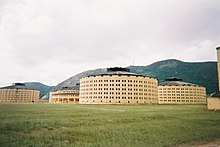Presidio Modelo: Difference between revisions
m date formats per MOS:DATEFORMAT by script |
Cyberbot II (talk | contribs) Rescuing 1 sources. #IABot |
||
| Line 11: | Line 11: | ||
Most of the survivors of the rebel attacks on [[Moncada Barracks]], including one attack leader, [[Fidel Castro]], and his brother, [[Raul Castro]], were imprisoned there, most from 1953 to 1955.<ref>{{cite web|url=http://www.cuba-solidarity.org.uk/cubasi_article.asp?ArticleID=115 |title=Cuba Solidarity Campaign : Cuba Si : Presidio Modelo, School of Revolutionaries |publisher=Cuba-solidarity.org.uk |date= |accessdate=November 6, 2012}}</ref> |
Most of the survivors of the rebel attacks on [[Moncada Barracks]], including one attack leader, [[Fidel Castro]], and his brother, [[Raul Castro]], were imprisoned there, most from 1953 to 1955.<ref>{{cite web|url=http://www.cuba-solidarity.org.uk/cubasi_article.asp?ArticleID=115 |title=Cuba Solidarity Campaign : Cuba Si : Presidio Modelo, School of Revolutionaries |publisher=Cuba-solidarity.org.uk |date= |accessdate=November 6, 2012}}</ref> |
||
After Fidel Castro's revolutionary triumph in 1959, Presidio Modelo was used to jail political dissidents, counter-revolutionaries, [[homosexuality|homosexuals]], [[Jehovah's Witnesses]], and anyone else considered unfit or an enemy to the new norms and dictates of the Socialist Cuban State.{{citation needed|date=December 2015}} By 1961, due to the overcrowded conditions (6,000 to 8,000 [[political prisoner]]s at one time), it was the site of various riots and [[hunger strike]]s, especially just before the [[Bay of Pigs invasion]], when orders were given to line the tunnels underneath the entire prison with several tons of [[TNT]].<ref>http://www.cubanet.org/prisiones/testimonios/30_1.htm |
After Fidel Castro's revolutionary triumph in 1959, Presidio Modelo was used to jail political dissidents, counter-revolutionaries, [[homosexuality|homosexuals]], [[Jehovah's Witnesses]], and anyone else considered unfit or an enemy to the new norms and dictates of the Socialist Cuban State.{{citation needed|date=December 2015}} By 1961, due to the overcrowded conditions (6,000 to 8,000 [[political prisoner]]s at one time), it was the site of various riots and [[hunger strike]]s, especially just before the [[Bay of Pigs invasion]], when orders were given to line the tunnels underneath the entire prison with several tons of [[TNT]].<ref>{{cite web|url=http://www.cubanet.org/prisiones/testimonios/30_1.htm |accessdate=November 21, 2010 |deadurl=yes |archiveurl=http://web.archive.org/web/20110616054703/http://www.cubanet.org/prisiones/testimonios/30_1.htm |archivedate=June 16, 2011 }}</ref> |
||
Prominent Cuban political prisoners such as [[Armando Valladares]],<ref>{{cite web|url=http://archive.newsmax.com/archives/articles/2003/12/4/173407.shtml |title=Armando Valladares: Human Rights Hero |publisher=Archive.newsmax.com |date=December 5, 2003 |accessdate=November 6, 2012}}</ref> [[Roberto Martín Pérez]],<ref>{{cite web|url=http://eichikawa.com/2010/09/roberto-martin-perez-he-hecho-un-libro-polemico.html |title=Emilio Ichikawa » Roberto Martín Pérez: “He hecho un libro polémico” |publisher=Eichikawa.com |date=November 2, 2012 |accessdate=November 6, 2012}}</ref> and [[Pedro Luis Boitel]]<ref>{{cite web|url=http://www.ned.org/about/board/meet-our-president/archived-remarks-and-presentations/092409 |title=Pedro Luis Boitel and the Future of Freedom in Cuba | National Endowment for Democracy |publisher=Ned.org |date= |accessdate=November 6, 2012}}</ref> were held there at one point or another during their respective incarcerations. It was permanently closed by the government in 1967.<ref name="wordpress1"/> |
Prominent Cuban political prisoners such as [[Armando Valladares]],<ref>{{cite web|url=http://archive.newsmax.com/archives/articles/2003/12/4/173407.shtml |title=Armando Valladares: Human Rights Hero |publisher=Archive.newsmax.com |date=December 5, 2003 |accessdate=November 6, 2012}}</ref> [[Roberto Martín Pérez]],<ref>{{cite web|url=http://eichikawa.com/2010/09/roberto-martin-perez-he-hecho-un-libro-polemico.html |title=Emilio Ichikawa » Roberto Martín Pérez: “He hecho un libro polémico” |publisher=Eichikawa.com |date=November 2, 2012 |accessdate=November 6, 2012}}</ref> and [[Pedro Luis Boitel]]<ref>{{cite web|url=http://www.ned.org/about/board/meet-our-president/archived-remarks-and-presentations/092409 |title=Pedro Luis Boitel and the Future of Freedom in Cuba | National Endowment for Democracy |publisher=Ned.org |date= |accessdate=November 6, 2012}}</ref> were held there at one point or another during their respective incarcerations. It was permanently closed by the government in 1967.<ref name="wordpress1"/> |
||
Revision as of 02:58, 21 March 2016
This article needs additional citations for verification. (October 2010) |


The Presidio Modelo was a "model prison" of Panopticon design, built on Isla de Pinos (now the Isla de la Juventud) in Cuba. It is located in the suburban quarter of Chacón, Nueva Gerona.
Overview
The prison was built under the President-turned-dictator Gerardo Machado between 1926 and 1928.[1] The five circular blocks, with cells constructed in tiers around central observation posts, were built with the capacity to house up to 2,500 prisoners in humane conditions.
Most of the survivors of the rebel attacks on Moncada Barracks, including one attack leader, Fidel Castro, and his brother, Raul Castro, were imprisoned there, most from 1953 to 1955.[2]
After Fidel Castro's revolutionary triumph in 1959, Presidio Modelo was used to jail political dissidents, counter-revolutionaries, homosexuals, Jehovah's Witnesses, and anyone else considered unfit or an enemy to the new norms and dictates of the Socialist Cuban State.[citation needed] By 1961, due to the overcrowded conditions (6,000 to 8,000 political prisoners at one time), it was the site of various riots and hunger strikes, especially just before the Bay of Pigs invasion, when orders were given to line the tunnels underneath the entire prison with several tons of TNT.[3]
Prominent Cuban political prisoners such as Armando Valladares,[4] Roberto Martín Pérez,[5] and Pedro Luis Boitel[6] were held there at one point or another during their respective incarcerations. It was permanently closed by the government in 1967.[1]
The prison now serves as a museum and is declared a national monument, and the old administration building now serves as a school and research center.
See also
References
- ^ a b "Presidio Modelo in Cuba and the panopticon idea « dpr-barcelona". Dprbcn.wordpress.com. April 18, 2012. Retrieved November 6, 2012.
- ^ "Cuba Solidarity Campaign : Cuba Si : Presidio Modelo, School of Revolutionaries". Cuba-solidarity.org.uk. Retrieved November 6, 2012.
- ^ http://web.archive.org/web/20110616054703/http://www.cubanet.org/prisiones/testimonios/30_1.htm. Archived from the original on June 16, 2011. Retrieved November 21, 2010.
{{cite web}}: Missing or empty|title=(help); Unknown parameter|deadurl=ignored (|url-status=suggested) (help) - ^ "Armando Valladares: Human Rights Hero". Archive.newsmax.com. December 5, 2003. Retrieved November 6, 2012.
- ^ "Emilio Ichikawa » Roberto Martín Pérez: "He hecho un libro polémico"". Eichikawa.com. November 2, 2012. Retrieved November 6, 2012.
- ^ "Pedro Luis Boitel and the Future of Freedom in Cuba | National Endowment for Democracy". Ned.org. Retrieved November 6, 2012.
External links
- [1]
- Museum “Presidio Modelo”
- Presidio Modelo
- CubaSi.cu. "The Model Prison". Cuba Heritage.org. Retrieved January 17, 2014.
